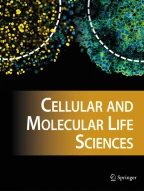3196Accesses
6Altmetric
Abstract.
Lysyl oxidase (LOX) oxidizes the side chain of peptidyl lysine converting specific lysine residues to residues of α-aminoadipic-δ-semialdehyde. This posttranslational chemical change permits the covalent crosslinking of the component chains of collagen and those of elastin, thus stabilizing the fibrous deposits of these proteins in the extracellular matrix. Four LOX-like (LOXL) proteins with varying degrees of similarity to LOX have been described, constituting a family of related proteins. LOX is synthesized as a preproprotein which emerges from the cell as proLOX and then is processed to the active enzyme by proteolysis. In addition to elastin and collagen, LOX can oxidize lysine within a variety of cationic proteins, suggesting that its functions extend beyond its role in the stabilization of the extracellular matrix. Indeed, recent findings reveal that LOX and LOXL proteins markedly influence cell behavior including chemotactic responses, proliferation, and shifts between the normal and malignant phenotypes.
This is a preview of subscription content,log in via an institution to check access.
Access this article
Subscribe and save
- Get 10 units per month
- Download Article/Chapter or eBook
- 1 Unit = 1 Article or 1 Chapter
- Cancel anytime
Buy Now
Price includes VAT (Japan)
Instant access to the full article PDF.
Similar content being viewed by others
Author information
Authors and Affiliations
Department of Biochemistry, Boston University School of Medicine, 715 Albany St., Boston, Massachusetts, 02118, USA
H. A. Lucero & H. M. Kagan
- H. A. Lucero
You can also search for this author inPubMed Google Scholar
- H. M. Kagan
You can also search for this author inPubMed Google Scholar
Corresponding author
Correspondence toH. M. Kagan.
Additional information
Received 31 March 2006; received after revision 17 May 2006; accepted 15 June 2006
Rights and permissions
About this article
Cite this article
Lucero, H.A., Kagan, H.M. Lysyl oxidase: an oxidative enzyme and effector of cell function.Cell. Mol. Life Sci.63, 2304–2316 (2006). https://doi.org/10.1007/s00018-006-6149-9
Published:
Issue Date:
Share this article
Anyone you share the following link with will be able to read this content:
Sorry, a shareable link is not currently available for this article.
Provided by the Springer Nature SharedIt content-sharing initiative



